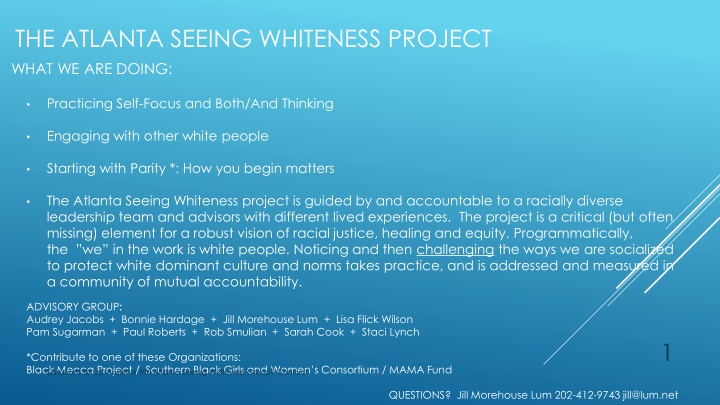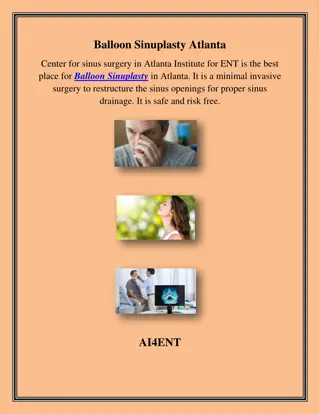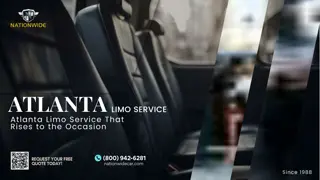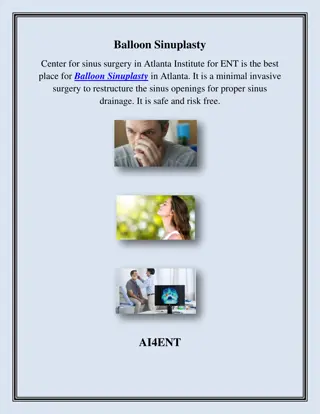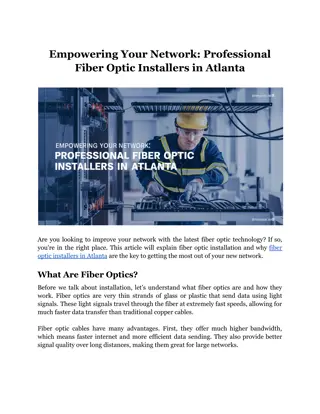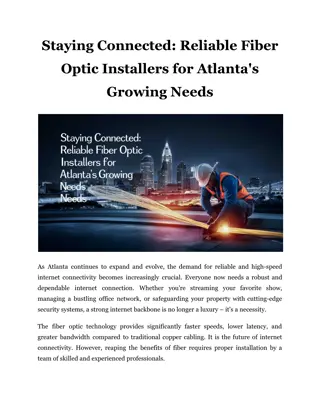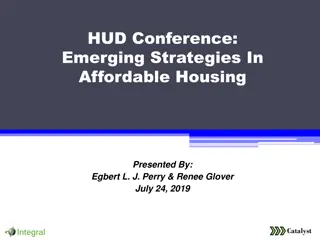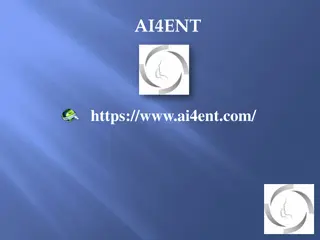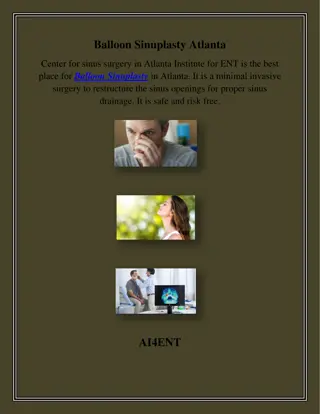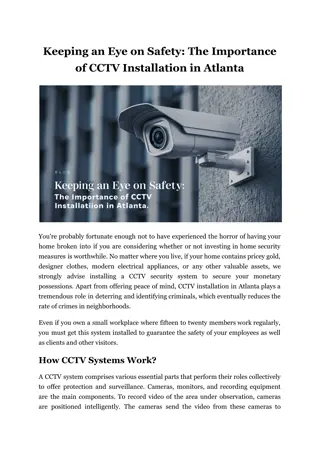THE ATLANTA SEEING WHITENESS PROJECT
Practicing self-focus and Both/And thinking to challenge white dominant culture norms, the project aims for racial equity. Led by a diverse team, it addresses systemic inequities and offers a working definition of racism as a power system that disadvantages non-preferred racial groups.
Uploaded on Feb 20, 2025 | 4 Views
Download Presentation

Please find below an Image/Link to download the presentation.
The content on the website is provided AS IS for your information and personal use only. It may not be sold, licensed, or shared on other websites without obtaining consent from the author.If you encounter any issues during the download, it is possible that the publisher has removed the file from their server.
You are allowed to download the files provided on this website for personal or commercial use, subject to the condition that they are used lawfully. All files are the property of their respective owners.
The content on the website is provided AS IS for your information and personal use only. It may not be sold, licensed, or shared on other websites without obtaining consent from the author.
E N D
Presentation Transcript
THE ATLANTA SEEING WHITENESS PROJECT WHAT WE ARE DOING: Practicing Self-Focus and Both/And Thinking Engaging with other white people Starting with Parity *: How you begin matters The Atlanta Seeing Whiteness project is guided by and accountable to a racially diverse leadership team and advisors with different lived experiences. The project is a critical (but often missing) element for a robust vision of racial justice, healing and equity.Programmatically, the we in the work is white people. Noticing and then challenging the ways we are socialized to protect white dominant culture and norms takes practice, and is addressed and measured in a community of mutual accountability. ADVISORY GROUP: Audrey Jacobs + Bonnie Hardage + Jill Morehouse Lum + Lisa Flick Wilson Pam Sugarman + Paul Roberts + Rob Smulian + Sarah Cook + Staci Lynch 1 *Contribute to one of these Organizations: Black Mecca Project / Southern Black Girls and Women s Consortium / MAMA Fund Questions for JC Austin or the Atlanta Seeing Whiteness Group? Contact QUESTIONS? Jill Morehouse Lum 202-412-9743 jill@lum.net
THE COLOR OF WHITENESS: FAITHFULLY ENGAGING ISSUES OF RACE FROM THE INSIDE OUT The Rev. J.C. Austin 2
The White Concept of Race in the U.S. In the science of color, the color white has no hue; it is achromatic Similarly, in dominant U.S. cultural discourse, whiteness = the absence of color Being white = a nonracial identity; it is simply normal. So only people of color have a racial identity; color/race is a subset of the norm Therefore, white people often conclude the solution to racial division is to simply not see color. But ONLY a white person in the U.S. has the privilege of not seeing color, and doing so whitewashes (pun intended) the systemic inequities for people of color 4
The White Concept of Racism The idea that refusing to see color as a solution to racism requires a particular understanding of what racism is Specifically, one has to believe that racism is: A problem of individuals, not systems A problem of bad people, not good ones A problem of intent, not impact Operating under this concept, one concludes: Systems can t be racist Good people can t be racist If my intentions aren t racist, then my words and actions can t be racist 5
A Working Definition of Racism: Racism is a set of social, political, and economic systems that: a)actively promotes the interests, power, and well-being of one racial group over others; and, b)actively undermines the interests, power and well-being of the non-preferred racial groups in the process Prejudice is an opinion, belief, or perspective; racism is a power system that creates and perpetuates unfair advantages for one group and unfair disadvantages to others 6
Whiteness and Intersectionality One common denial of the reality that white people have unearned advantages is that they experience all kinds of adversity: how can I have white privilege if I m broke?!? Having white privilege does NOT mean that your life is privileged in every aspect Important to understand the reality of intersectionality here: Intersectionality is the dynamics of overlapping patterns of oppressive systems Oppressive systems operate in relationship with one another, not independently You may have multiple oppressed identities, or some identities that are oppressed while others are privileged 7
Its a Lot More than Okay to be White Jane Elliot: If you as a white person would be happy to be treated as our society treats black people [people of color], please stand. White privilege is a set of advantages or immunities white people daily benefit from beyond those common to all others. (Arlene Avakian) 8
Discussion Questions 1. What is the difference between advantages and immunities ? 2. What are some of the advantages white people have in the U.S. that you have experienced or witnessed? What are some immunities? 9
Hitting the Wall of White Fragility White fragility: when even relatively small amounts of racial stress quickly becomes intolerable for white people (Robin DiAngelo) Triggers a range of defensive moves designed to restore the white sense of racial equilibrium: o Becoming angry, hurt, or offended o Silence/withdrawal o Personalizing issues of systemic racism o Minimizing, contesting, or delegitimizing examples of racial injustice Ultimately, white fragility attempts to privilege white emotions over experiences and needs of people of color ( white tears ) 10
Honey Pot Super Bowl 2020 Ad The reason why it s so important for Honey Pot to do well is so that the next Black girl that comes up with a great idea, she can have a better opportunity. That means a lot to me. 11
Georgia Declaration of Secession, January 1861 The people of Georgia having dissolved their political connection with the Government of the United States of America, present to their confederates and the world the causes which have led to the separation. For the last ten years we have had numerous and serious causes of complaint against our non-slave-holding confederate States with reference to the subject of African slavery. They have endeavored to weaken our security, to disturb our domestic peace and tranquility, and persistently refused to comply with their express constitutional obligations to us in reference to that property, and by the use of their power in the Federal Government have striven to deprive us of an equal enjoyment of the common Territories of the Republic Our people, still attached to the Union from habit and national traditions, and averse to change, hoped that time, reason, and argument would bring, if not redress, at least exemption from further insults, injuries, and dangers. Recent events have fully dissipated all such hopes and demonstrated the necessity of separation. 15
Discussion Questions: 1)When have you have personally experienced/witnessed white fragility? Tell the story. 2)What makes you uneasy about dealing with issues of racial injustice in your family, organization, and/or community? 16
The Problem of Fear White people are afraid of: admitting the lack of equal opportunity in the USA losing their current power and privilege (white men vs. white women) being misunderstood in conversations about race revealing anything that might challenge whether we re one of the good ones 17
The Power of Grace and Courage Robin DiAngelo to POC: How often have you tried to give white people feedback on their racist patterns and had that go well for you? What would it be like if you could just give us that feedback and have it received with grace, reflected, and sought to change the behavior? Becoming a race traitor 18 The importance of leading by following
THE POWER OF PRACTICE What does it mean to practice something? Concrete, definable actions You do it for a particular purpose, which isn't the same thing as the specific outcome You do it repeatedly, over time, to get better at it There are standards of excellence; you can practice well or badly They connect and overlap with each other to create an integrated whole 19
FIVE COMMITMENTS TO RACIAL JUSTICE FOR WHITE PEOPLE 1. Learn About The Realities of Race in U.S. History and Society 2. Break Out of White Self-Segregation 3. Educate Myself About the Hopes, Fears, and Desires of People of Color Today 4. Engage and Challenge Racism and Prejudice in White Social Circles 5. Take Intentional Public Action 20
FIVE COMMITMENTS TO RACIAL JUSTICE FOR WHITE PEOPLE Discussion Questions: 1. Which of these commitments is the easiest for you? The most challenging? Why? 2. What are some other good ways to combat white self-segregation? What are the obstacles to doing so? 3. Can you recall a time when you disrupted a conversation that involved racial stereotyping and/or racist comments? Why did you act then? What has held you back from doing the same thing in other situations? 21
THE ATLANTA SEEING WHITENESS PROJECT WHAT WE ARE DOING: Practicing Self-Focus and Both/And Thinking Engaging with other white people Starting with Parity *: How you begin matters The Atlanta Seeing Whiteness project is guided by and accountable to a racially diverse leadership team and advisors with different lived experiences. The project is a missing element for a robust vision of racial justice, healing and equity.Programmatically, the we in the work is white people. Noticing and then challenging the ways white people are socialized to protect white dominant culture and norms takes practice, and is addressed and measured in a community of mutual accountability. ADVISORY GROUP: Audrey Jacobs + Bonnie Hardage + Jill Morehouse Lum + Lisa Flick Wilson Pam Sugarman + Paul Roberts + Rob Smulian + Sarah Cook + Staci Lynch 22 *Contribute to one of these Organizations: Black Mecca Project / Southern Black Girls and Women s Consortium / MAMA Fund
Questions from Session #1: Questions from Session #1: 1. Due to my upbringing of feeling that it is bad to see black/white, the title "Seeing Whiteness" makes me uncomfortable and imagine that it would strike a chord with others in getting involved. Especially progressive friends that would likely be defensive about the need to explore their whiteness. Could you speak to this? 2. What is a realistic way to begin*? This felt like the tip of an iceberg with our racial patterns. I myself felt layers of unacknowledged assumptions starting to peel away. What surprised me was what I thought I understood, and how much there is to learn. 3. I'm unsure how to best begin talking about these topics with staff. (60% white and 40% POC). Is it helpful to normalize the discomfort that white people may experience as we discuss these topics before getting started? 4. I want to make room for black leadership; how do I do that? 5. I felt like you were saying to not take a leadership role as a white person. Does that mean to contribute money to a black-led organization? 6. Why do you (Atlanta Seeing Whiteness Project) say that you "Begin with parity? 23
Break out Directions Let everyone speak once before anyone speaks twice. Then comment on what resonated. This means: Do not comment or ask questions about what someone has said until everyone has had an opportunity to speak. Tip: Do Not Preface. Practice just saying the thing! Try on saying Time at 90 seconds. (How did that feel?) There may be some silence. If that feels uncomfortable to you, just notice that. There are four of you. You don t need a facilitator. When you are prompted to Join Breakout Room Click Join to enter When the time is up for the breakouts to be over you will receive 1 minute notice and then will be automatically rejoined to the full group. 24 Take a moment now to sit quietly with the question....
GUIDING VOICES FOR THE ATLANTA SEEING WHITENESS GROUP You have to decide if you want to be well. If you want to be well you have to look at the truth. What does it have to do with me? If you are white, you have to deal with the fact that you are the inheritor of the benefits of white supremacy. And if you are a person of color you have inherited the narrative of inferiority and less than and you have to work on that. These are two realities we have to face up to. And when we do, then we can begin looking at-- Okay, so what I need to do so I can be well? I am an evangelist for, Let's get well, whatever that takes. Catherine Meeks, Episcopal Diocese Atl from an interview with Rose Scott. "I was taught not to see myself in racial terms, and certainly not to draw attention to my race or behave as if it mattered in any way. Of course, I was made aware that somebody's race mattered and if race was discussed, it would be there's not mine. Yet a critical component of cross-racial skill building is being able to sit with the discomfort of being seen racially, of having to proceed as if our race matters (which it does). Robin DiAngelo, author of White Fragility 25
GUIDING VOICES FOR THE ATLANTA SEEING WHITENESS GROUP Why talk about race, just together with white people? "In your own safe spaces, ask yourself the tough questions. You don t need a black woman/person as your seer. From your honest dialogue and answers, you ll come out stronger and more informed on the real and persistent manifestations of racism on your black sisters, what it means, and your response. Lesley Grady, formerly Community Foundation of Greater Atlanta "Practice in situations where the perceived risk is much higher than the actual risk...Try it yourself. Think of something you want to get better at: giving feedback, listening, being succinct and direct, having hard conversations...Now, try that skill in a low-risk situation. Go slowly and feel all the feelings that come up. Those are the feelings you will feel in higher risk situations because that s what risk feels like. So follow through and feel the risk, knowing that the actual consequences of failure are quite low. Why do any of this? Because that s how we expand our freedom to act on what s most important to us." Peter Bregman, To Develop Leadership Skills, Practice in a Low-Risk Environment, Harvard Business Review, April 5, 2019. 26
